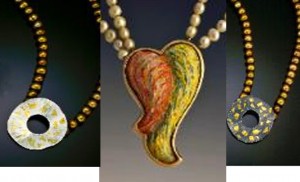 When I ran the gallery, I represented artists who worked in a variety of mediums, precious metals and gemstones, aluminum, resin, even one who produced really striking jewelry using the pages of comic books. For every one artist I represented I probably looked at the work of another several hundred.
When I ran the gallery, I represented artists who worked in a variety of mediums, precious metals and gemstones, aluminum, resin, even one who produced really striking jewelry using the pages of comic books. For every one artist I represented I probably looked at the work of another several hundred.
In over a decade of looking at work every day, I developed a few prejudices that guided my choices on which artists I offered representation.
I recently came across a couple of examples that precisely illustrate the type of work which would make me pause. (Now these of course are my own opinions. But they are backed by years of study and so might have some value.)
Jewelry Design and Technique
In making jewelry, design is central. A flawed design results in a flawed piece however accomplished the technique. But without technique, designs, however good, cannot be executed. So, both play a hugely important role in making jewelry.
A third area of importance is gemstone knowledge. If you use gemstones in your work, then you must take the trouble to learn a little about them. You need not be an expert, but you must be able to distinguish between, for example, quality pearls and pearls that are commercial grade. The improper or careless use of gemstones can make or break a design.
In the examples above, the gemstones, the pearls, flaw the design, although the metal work is pretty good.
So, let’s look a little closer.
Metal Work and Pearl and Bead Stringing
The work above, by two jewelry makers, illustrates the pitfalls that can occur when technique, including gemstone knowledge, falls short of design objectives.
In all three cases, the metal work is pretty good. The first and third pendants uses a technique that includes fusing tiny pieces of gold foil to sterling silver. This is a delicate and sophisticated technique calling for some mastery of the torch. The pendants are hammered and one is oxidized.
The middle pendant is enameled and set in gold.
So far, so good. But when you look at the pieces, you recognize intuitively that something’s wrong.
Listen to that intuition, because you’re right. All three pieces use commercial grade pearls of the wrong color and size. The size and color pulls the eye away from the central design element and conflicts with it. This sloppy choice of pearls degrades the work and ruins the design although the pendents themselves are fine.
It’s as if the metalsmiths couldn’t step out of their niches to learn the techniques associated with another niche or to learn the most basic pearl quality factors.
Collaboration
This is exactly the problem. They obviously didn’t deliberately choose to ruin their designs. Those pendants require quite a bit of work. But by choosing to remain ignorant of pearl basics, that’s what happened.
When I ran the gallery, occasionally a metalsmith would ask me to collaborate on a design. (Although I did my own metalwork, I also produced pearl and bead strung jewelry and taught it.) Similarly, a number of metalsmiths took my course.
These artists looked beyond their own niches to discern the techniques they required from other niches to achieve their design objectives. They produced beautiful jewelry.
It’s an important lesson.

